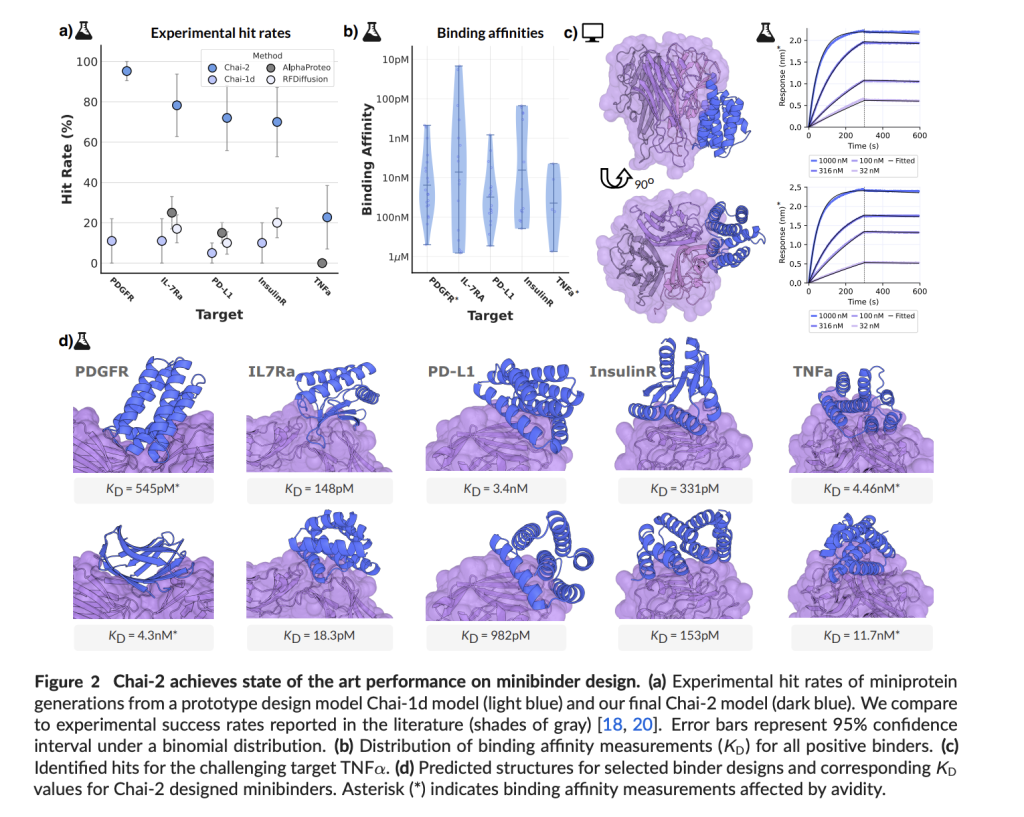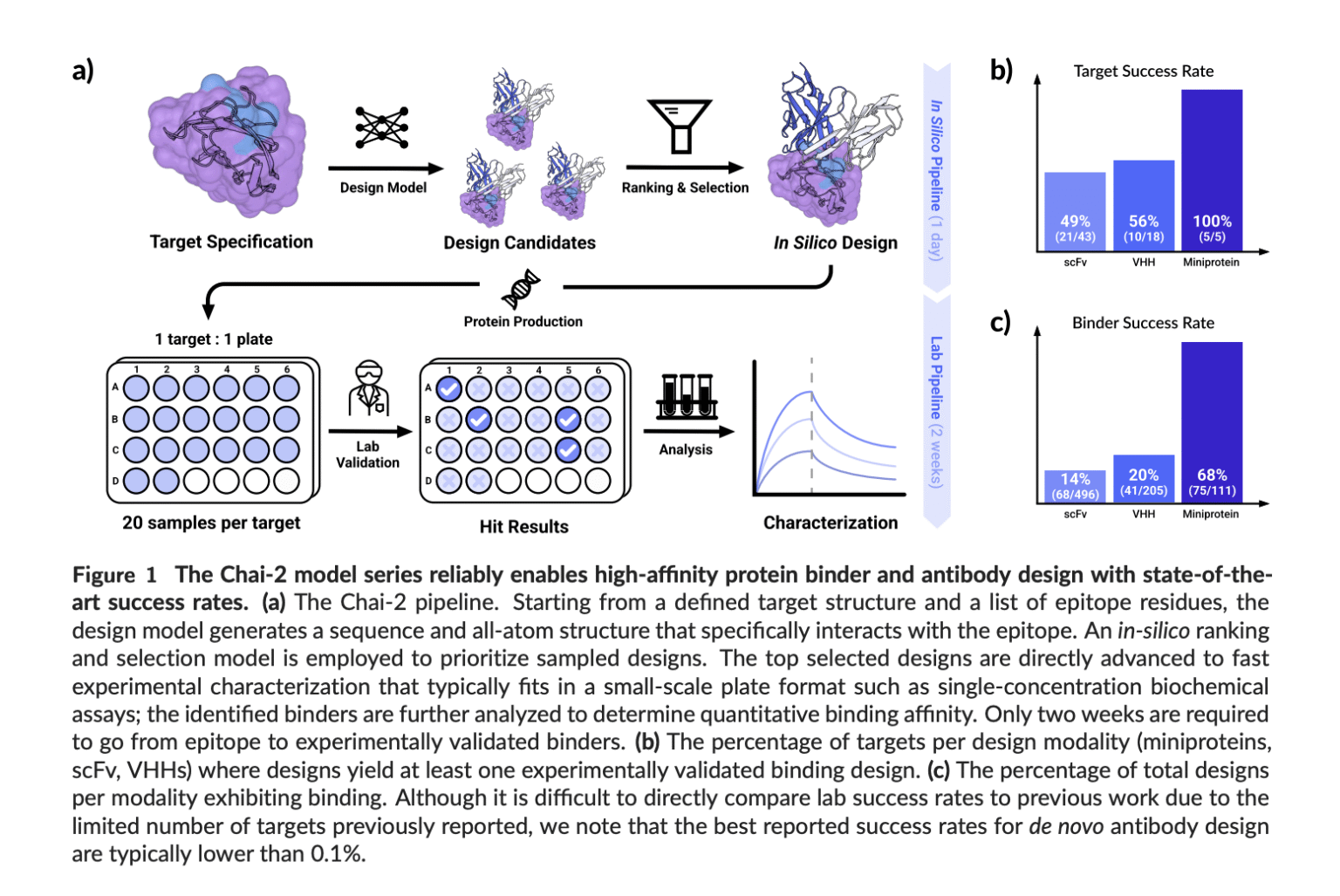TLDR: Chai Discovery Team introduces Chai-2, a multimodal AI model that enables zero-shot de novo antibody design. Achieving a 16% hit rate across 52 novel targets using ≤20 candidates per target, Chai-2 outperforms prior methods by over 100x and delivers validated binders in under two weeks—eliminating the need for large-scale screening.
In a significant advancement for computational drug discovery, the Chai Discovery Team has introduced Chai-2, a multimodal generative AI platform capable of zero-shot antibody and protein binder design. Unlike previous approaches that rely on extensive high-throughput screening, Chai-2 reliably designs functional binders in a single 24-well plate setup, achieving more than 100-fold improvement over existing state-of-the-art (SOTA) methods.
Chai-2 was tested on 52 novel targets, none of which had known antibody or nanobody binders in the Protein Data Bank (PDB). Despite this challenge, the system achieved a 16% experimental hit rate, discovering binders for 50% of the tested targets within a two-week cycle from computational design to wet-lab validation. This performance marks a shift from probabilistic screening to deterministic generation in molecular engineering.
AI-Powered De Novo Design at Experimental Scale
Chai-2 integrates an all-atom generative design module and a folding model that predicts antibody-antigen complex structures with double the accuracy of its predecessor, Chai-1. The system operates in a zero-shot setting, generating sequences for antibody modalities like scFvs and VHHs without requiring prior binders.
Key features of Chai-2 include:
- No target-specific tuning required
- Ability to prompt designs using epitope-level constraints
- Generation of therapeutically relevant formats (miniproteins, scFvs, VHHs)
- Support for cross-reactivity design between species (e.g., human and cyno)
This approach allows researchers to design ≤20 antibodies or nanobodies per target and bypass the need for high-throughput screening altogether.
Benchmarking Across Diverse Protein Targets
In rigorous lab validations, Chai-2 was applied to targets with no sequence or structure similarity to known antibodies. Designs were synthesized and tested using bio-layer interferometry (BLI) for binding. Results show:
- 15.5% average hit rate across all formats
- 20.0% for VHHs, 13.7% for scFvs
- Successful binders for 26 out of 52 targets
Notably, Chai-2 produced hits for hard targets such as TNFα, which has historically been intractable for in silico design. Many binders showed picomolar to low-nanomolar dissociation constants (KDs), indicating high-affinity interactions.
Novelty, Diversity, and Specificity
Chai-2’s outputs are structurally and sequentially distinct from known antibodies. Structural analysis showed:
- No generated design had
- All CDR sequences had >10 edit distance from the closest known antibody
- Binders fell into multiple structural clusters per target, suggesting conformational diversity
Additional evaluations confirmed low off-target binding and comparable polyreactivity profiles to clinical antibodies like Trastuzumab and Ixekizumab.

Design Flexibility and Customization
Beyond general-purpose binder generation, Chai-2 demonstrates the ability to:
- Target multiple epitopes on a single protein
- Produce binders across different antibody formats (e.g., scFv, VHH)
- Generate cross-species reactive antibodies in one prompt
In a cross-reactivity case study, a Chai-2 designed antibody achieved nanomolar KDs against both human and cyno variants of a protein, demonstrating its utility for preclinical studies and therapeutic development.
Implications for Drug Discovery
Chai-2 effectively compresses the traditional biologics discovery timeline from months to weeks, delivering experimentally validated leads in a single round. Its combination of high success rate, design novelty, and modular prompting marks a paradigm shift in therapeutic discovery workflows.
The framework can be extended beyond antibodies to miniproteins, macrocycles, enzymes, and potentially small molecules, paving the way for computational-first design paradigms. Future directions include expanding into bispecifics, ADCs, and exploring biophysical property optimization (e.g., viscosity, aggregation).
As the field of AI in molecular design matures, Chai-2 sets a new bar for what can be achieved with generative models in real-world drug discovery settings.
Check out the Technical Report. All credit for this research goes to the researchers of this project. Also, feel free to follow us on Twitter, Youtube and Spotify and don’t forget to join our 100k+ ML SubReddit and Subscribe to our Newsletter.
Asif Razzaq is the CEO of Marktechpost Media Inc.. As a visionary entrepreneur and engineer, Asif is committed to harnessing the potential of Artificial Intelligence for social good. His most recent endeavor is the launch of an Artificial Intelligence Media Platform, Marktechpost, which stands out for its in-depth coverage of machine learning and deep learning news that is both technically sound and easily understandable by a wide audience. The platform boasts of over 2 million monthly views, illustrating its popularity among audiences.



